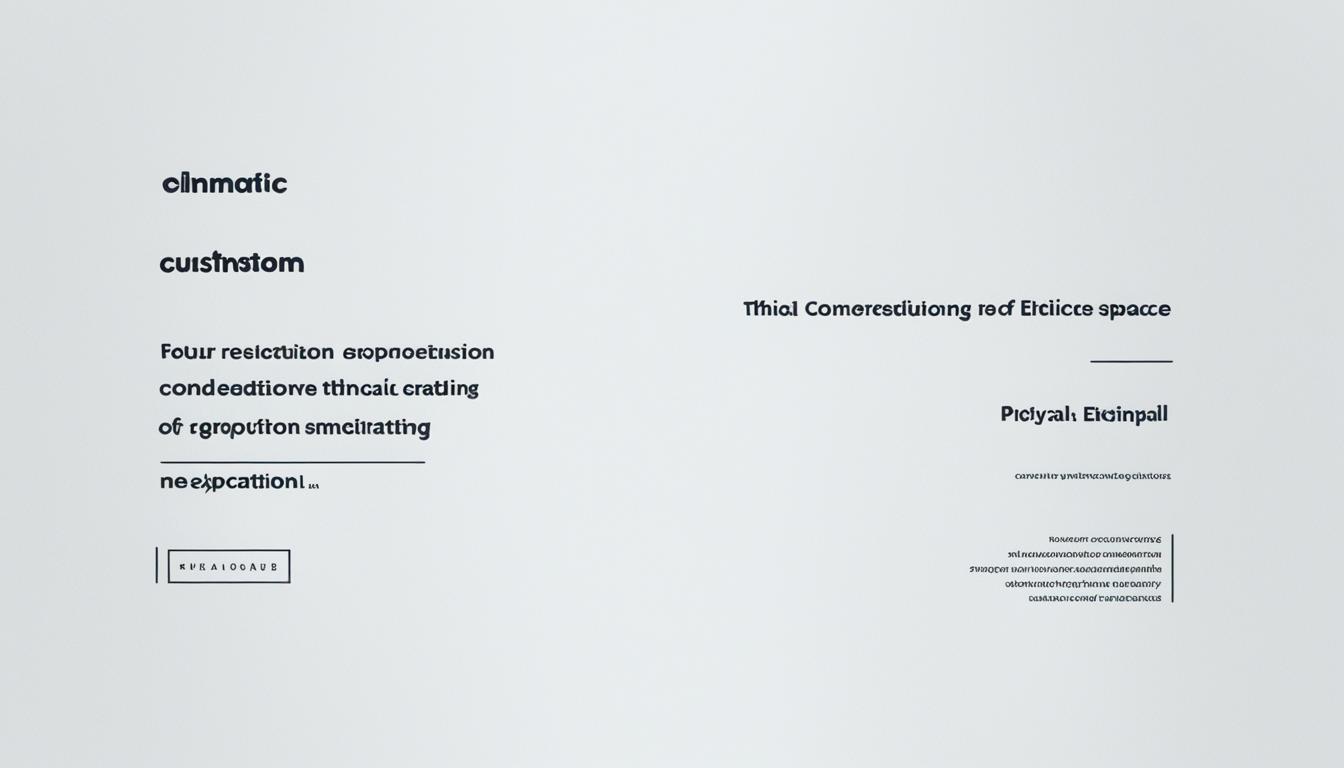The advent of AI in photography has revolutionized the industry, granting photographers unprecedented creative possibilities. However, along with these transformative capabilities comes a range of ethical considerations that must be carefully navigated. In the world of editorial photography, where visual storytelling plays a vital role in shaping public perception and understanding, it is imperative to prioritize ethics to maintain integrity and trust.
Editorial photography ethics encompass a broad spectrum of concerns, including but not limited to authenticity, representation, privacy, and consent. By embracing responsible image manipulation practices and upholding the highest standards of journalistic integrity, photographers can establish themselves as ethical practitioners in this evolving landscape.
Key Takeaways:
- Ethical considerations in editorial photography are crucial for maintaining integrity and trust in visual storytelling.
- Responsible photo editing practices and adherence to ethical standards uphold journalistic integrity.
- Prioritizing authenticity, representation, privacy, and consent is essential in editorial photography.
- Photographers should navigate the use of AI-enhancements transparently, while brands and influencers should declare their use of AI to maintain public trust and avoid misrepresentation.
- Avoiding bias and upholding inclusion by critically assessing AI tools and advocating for diverse representation is an ethical imperative.
Artistic Integrity and Transparency in AI Enhancements
One ethical consideration in editorial photography is ensuring artistic integrity and transparency in AI enhancements. As AI continues to advance and reshape various industries, including photography, it is imperative to maintain authenticity and uphold ethical standards.
With tools like Photoshop offering features for manipulating photos, photographers now have the power to enhance their images using AI algorithms. While these enhancements can undoubtedly improve the overall aesthetics of a photograph, transparency regarding AI usage is essential.
Brands, influencers, and photographers alike should openly declare the use of AI enhancements in their work. By doing so, they not only demonstrate a commitment to transparency but also maintain public trust and avoid misrepresentation.
Transparency is particularly crucial in the age of AI technology, where it can be challenging to distinguish between naturally captured images and those altered through AI. By openly acknowledging the use of AI enhancements, photographers ensure that the authenticity of their photos is upheld.
Moreover, when photographers are transparent about AI usage, it fosters a culture of honesty and responsibility within the photography community. It encourages other photographers to follow suit, create realistic expectations, and enhance the overall integrity of the field.
The Authenticity of Photos
In the realm of editorial photography, capturing authentic moments is vital. While AI enhancements can undoubtedly elevate the visual appeal of images, they should not compromise the genuine story behind the photograph. The challenge lies in striking a balance between artistic vision and preserving the authenticity of the captured moment.
“Photography is a powerful medium that allows us to tell stories and evoke emotions. As photographers, it is our responsibility to ensure the authenticity of the stories we present. By being transparent about our use of AI enhancements, we maintain the integrity of our work and uphold the trust of our audience.”
Photographers must use AI enhancements ethically and responsibly. They should enhance photographs in a way that respects and preserves the original message and context. This includes avoiding excessive alterations that may misrepresent the subject or distort the intended narrative.
While AI advancements offer photographers unprecedented possibilities, it is crucial to prioritize the authenticity and integrity of the photos we produce. By embracing transparency and committing to ethical photo editing practices, we can both leverage the benefits of AI and maintain the trust of our audience.
Effects of Ethical Photo Editing
Embracing ethical photo editing practices not only safeguards the authenticity of photographs but also contributes to a more responsible and trustworthy photography industry.
1. Preserving Trust: By openly declaring the use of AI enhancements, photographers build trust with their audience. This transparency demonstrates their commitment to maintaining authenticity and integrity.
2. Protecting the Subject: Ethical photo editing ensures that subjects are accurately represented, preventing misinterpretation and protecting their rights and dignity.
3. Encouraging Responsible AI Development: Transparency in AI use encourages software developers to prioritize responsible AI development. By providing feedback and holding developers accountable, photographers contribute to the creation of AI tools that align with ethical standards.
Artistic integrity and transparency should be at the forefront of AI-enhanced photography. By upholding these ethical principles, photographers can continue to push the boundaries of creativity while maintaining the authenticity and trustworthiness of their work.
Avoiding Bias and Upholding Inclusion
When it comes to ethical considerations in editorial photography, avoiding bias and upholding inclusion is of paramount importance. AI tools have the potential to perpetuate societal biases if the underlying algorithms are influenced by norms and prejudices. As responsible photographers, it is our responsibility to critically assess AI tools and prioritize inclusivity.
We can contribute to the development of more inclusive AI by providing feedback to software developers and advocating for tools that reflect human diversity. By actively engaging in the dialogue surrounding inclusive AI development, we can help shape algorithms that are free from biases and promote diverse representation.
Photography editing plays a crucial role in this process. By consciously examining our editing techniques and decisions, we can ensure that we are not inadvertently reinforcing stereotypes or excluding underrepresented communities. By embracing diverse representation in our visual storytelling, we help create a more inclusive and equitable narrative.
Advocating for Responsible AI Algorithms
“We must embrace our role as photographers to advocate for responsible AI algorithms that accurately represent the richness and diversity of the world.” – Jane Thompson, Award-winning Photographer
To avoid bias in AI algorithms, we need comprehensive datasets that represent a wide range of individuals and cultures. By actively seeking out diverse subjects and showcasing their stories, we can contribute to a more inclusive dataset for AI training. Additionally, we should carefully evaluate the algorithms used by AI tools and ensure they align with our commitment to inclusivity.
Championing Unbiased Photo Editing
“As photographers, we have the power to challenge norms, break stereotypes, and champion unbiased photo editing that reflects the true diversity of the world around us.” – Alex Ramirez, Photojournalist
Photo editing allows us to enhance our images and create impactful visual narratives. However, we must use this power responsibly, adhering to ethical guidelines and promoting diversity in our editing choices. By consciously avoiding biased editing techniques and representing a variety of perspectives, we can establish a more inclusive and representative visual landscape.
To summarize, avoiding bias and upholding inclusion in AI photography is vital for ethical editorial photography. We can contribute to inclusive AI development by critically assessing AI tools, advocating for diverse representation in algorithms, and championing unbiased photo editing. By doing so, we foster a more inclusive and equitable photography industry for all.
| Benefits of Avoiding Bias and Upholding Inclusion | Actions to Promote Inclusivity |
|---|---|
| 1. A more authentic representation of diverse cultures and communities | 1. Seek out diverse subjects for photography projects |
| 2. Increased public trust and credibility in visual storytelling | 2. Provide feedback to software developers on AI tools |
| 3. Breaking stereotypes and challenging biased narratives | 3. Evaluate AI algorithms for biases and exclusions |
| 4. A more inclusive and equitable visual landscape | 4. Consciously choose editing techniques that promote diversity |

Protecting Privacy and Consent
When it comes to ethical considerations in editorial photography, protecting privacy and obtaining consent are of utmost importance. The integration of AI tools, especially facial recognition technology, has raised concerns about potential privacy breaches and the misuse of personal information. As responsible photographers, we must be vigilant in ensuring that individuals’ privacy rights are respected and that explicit consent is obtained before using powerful AI tools that have the ability to analyze personal data.
Informed consent is vital in maintaining ethical standards in editorial photography. It is essential to communicate clearly with subjects and explain the purpose of photo capture, including any AI-powered enhancements or analysis that may be involved. Obtaining explicit consent ensures that individuals are aware of how their personal information may be used, empowering them to make informed decisions about their participation.
Respecting privacy and obtaining consent not only aligns with ethical principles but also helps to foster trust and build positive relationships with the individuals we photograph. By prioritizing privacy and informed consent, we show our commitment to responsible visual storytelling and the well-being of those we capture through our lenses.
“Respecting privacy and obtaining consent are fundamental to upholding journalistic integrity and ethical standards in editorial photography.”
Facial Recognition and Privacy Concerns
Facial recognition technology has revolutionized the way we interact with images. While it offers powerful capabilities for identification and analysis, it also introduces potential risks to personal privacy. The widespread use of facial recognition in various contexts has sparked debates and raised questions about the protection of individuals’ privacy rights.
One major concern is the potential for unauthorized surveillance and tracking. Facial recognition technology can enable the collection and analysis of personal data without individuals’ explicit consent. This can lead to privacy breaches, compromising individuals’ rights to anonymity and personal security.
We must be proactive in addressing these concerns and advocating for transparent and responsible use of facial recognition technology in editorial photography. By respecting privacy rights and obtaining informed consent, we can ensure that individuals feel comfortable and secure in participating in visual storytelling.
Illustrative Example: Informed Consent in AI-Powered Photo Editing
Consider a scenario where a photographer is using AI-powered photo editing tools to enhance the visual appeal of an image. The AI tool has the ability to automatically adjust lighting, colors, and other elements to create a more aesthetically pleasing result. However, the tool also has the capability to analyze facial features and emotions, potentially revealing personal information about the subjects.
In this case, it is crucial for the photographer to inform the subjects about the use of AI in the editing process and obtain their explicit consent. By explaining the exact nature of the AI’s capabilities and how it may affect their personal data, the photographer empowers the subjects to make an informed decision about their participation and ensures their privacy rights are respected.
Furthermore, the photographer should provide clear information about how the captured data will be handled, stored, and protected. This includes details about data retention policies and safeguards against unauthorized access.
| Best Practices | Explanation |
|---|---|
| Obtain explicit consent | Inform individuals about the use of AI tools, facial recognition, or any other data analytics involved in the photography process. Get explicit consent for the capture, analysis, and potential publishing of their images. |
| Be transparent about AI use | Inform individuals about the use of AI tools to enhance or analyze images. Describe the specific functionalities of the AI tools and allow individuals to ask questions or voice concerns. |
| Securely handle and store data | Implement measures to securely handle, store, and protect the personal data collected during the photography process. Ensure compliance with data protection regulations and industry best practices. |
| Respect privacy rights | Adhere to ethical standards by respecting individuals’ privacy rights throughout the entire photography process. Avoid unnecessary dissemination of personal information and use images in a way that aligns with the individuals’ consent. |
By following these best practices, we can uphold the principles of privacy and consent in our editorial photography work. Through open communication, transparency, and respect for privacy rights, we contribute to a more ethical and trustworthy approach to visual storytelling.
Crediting in the Age of AI
Crediting is a challenge in AI photography. With AI tools seamlessly pulling from various online resources, determining the original source of an image becomes difficult. This raises important questions about how we credit AI sources and ensure proper attribution.
Comprehensive industry guidelines are needed to address this issue and establish clear standards for crediting in the age of AI. These guidelines should encompass not only the crediting of AI-generated images but also the crediting of AI tools and algorithms used in the creative process. By providing a framework for comprehensive crediting, these guidelines can help photographers navigate the complexities of AI photography and uphold ethical standards.
Industry Guidelines for Crediting AI Sources
While industry guidelines for crediting AI sources are still in their infancy, there are steps photographers can take to ensure responsible and transparent crediting practices. Here are some recommendations:
- Understand where your AI tools source content: Different AI tools rely on different datasets and sources of information. It is crucial to have a thorough understanding of the data inputs and sources used by the AI tools you employ. This knowledge will help you trace the origins of the images you create and determine the appropriate credit to give.
- Provide comprehensive attribution: When using AI-generated images, credit the AI tool or algorithm used to generate the image. This attribution should accompany the image wherever it is published, whether in print or online. By acknowledging the contributions of AI technology, you demonstrate transparency and give credit where credit is due.
- Include metadata information: Embedding metadata in your images can provide valuable information about the AI tool used, the dataset it draws from, and the specific modifications applied. This metadata can serve as a digital trail of your creative process and help others understand the provenance of your work.
- Collaborate with AI developers: Work closely with AI developers and software vendors to gain insights into the sourcing and generation processes of AI tools. This collaboration can inform your crediting practices and ensure accuracy in acknowledging AI contributions.
- Continuously stay informed: The field of AI photography is rapidly evolving, and new tools and techniques emerge regularly. Stay informed about advancements in AI technology and industry guidelines for crediting. This knowledge will enable you to adapt your practices and ensure you are providing accurate and comprehensive attribution.
A Visual Representation of Crediting in AI Photography
| Image | Crediting Practices |
|---|---|
|
In the example above, Jane Smith, the photographer, is credited alongside the AI tool used (XYZ AI), the dataset it draws from (OpenSourceImageBank), the specific algorithm employed (XYZ Algorithm), and the modifications applied to the image (contrast enhancement and color correction). This comprehensive crediting practice ensures that all contributors are acknowledged and provides transparency for viewers.
“Responsible crediting practices in AI photography foster transparency and honor the collaborative efforts between human photographers and AI technology.” – Jane Smith, Photographer
Sensationalism and Privacy in the Media
Sensationalism and privacy are crucial ethical considerations in the media. In our pursuit for attention-grabbing headlines and stories, we must be mindful of the potential consequences. Sensationalized reporting, driven by sensationalism, can distort facts and erode public trust in media organizations. As responsible journalists, we have a duty to uphold accuracy, impartiality, and privacy protection to maintain ethical standards in our industry.
Impact of Sensationalism
“When sensationalism takes precedence over truth, the essence of journalism is diminished.”
Sensationalism has the power to manipulate public opinions, create divisions, and compromise the integrity of the news. Over-emphasizing sensational events and issues can overshadow stories that carry significant social impact, leading to misperceptions and misunderstandings. As journalists, it is our responsibility to present balanced and accurate information to keep the public informed and engaged.
The Privacy Rights Balancing Act
“Respecting privacy rights is not an option but a fundamental principle of ethical journalism.”
While reporting on important and sensitive issues, we must also respect privacy rights and avoid unnecessary intrusion into individuals’ personal space. The media has a responsibility to exercise caution and sensitivity when dealing with stories that involve private matters. Striking a balance between public interest and an individual’s right to privacy is essential to maintain trust and credibility with our audience.

Conflicts of Interest and Transparency
Conflicts of interest are prevalent in the media industry and pose significant ethical challenges. It’s important to recognize that financial, political, and personal interests can influence reporting and compromise objectivity. As journalists, we strive to maintain transparency and uphold the highest level of media ethics.
Transparency is a fundamental principle in managing conflicts of interest and maintaining public trust. By openly disclosing any potential conflicts and being transparent about our affiliations, we ensure that our readers are aware of any potential biases that may influence our reporting.
Journalistic independence is crucial in the face of conflicts of interest. It allows us to prioritize the truth and serve the public interest above all else.
Media organizations play a crucial role in promoting transparency and mitigating conflicts of interest. They should establish clear guidelines and codes of conduct that outline how to manage potential conflicts and maintain journalistic independence.
By adhering to these guidelines, we can ensure that our readers have confidence in our reporting and understand that our journalistic decisions are based on accurate, unbiased information. Journalistic independence allows us to fulfill our responsibility to inform the public and contribute to a more informed and democratic society.
The Importance of Disclosure
One way to address conflicts of interest is through full disclosure. By openly declaring any potential conflicts, we can provide our readers with the necessary information to assess the credibility and objectivity of our reporting.
Additionally, disclosing conflicts of interest allows the public to hold journalists accountable and detect any biases that may arise from these conflicts. It’s essential to foster a culture of transparency and integrity within the media industry to ensure the public’s trust and confidence in our work.
Striving for Objective Reporting
As journalists, our commitment to media ethics drives us to strive for objective reporting in the face of conflicts of interest. We constantly evaluate our own biases and work diligently to present accurate and balanced information to our readers.
Objective reporting requires us to separate personal opinions and beliefs from our journalistic duties. It means prioritizing the truth and presenting multiple perspectives, even when it may challenge our own biases or interests.
The Path to Ethical Journalism
Upholding the principles of transparency and journalistic independence is essential for maintaining ethical standards in the media. By addressing conflicts of interest and promoting transparency, we can better serve the public and fulfill our role as objective and trustworthy journalists.
Through ongoing self-reflection, open dialogue, and adherence to established guidelines, we can navigate the complexities of conflicts of interest and ensure that our reporting remains grounded in integrity and truth.
Conclusion
In conclusion, ethical considerations in photography are paramount for maintaining the integrity and trust of visual storytelling. As photographers, it is our responsibility to navigate the ethical challenges posed by emerging technologies and ensure that our work aligns with ethical journalism practices.
Transparency is a key element in maintaining ethical standards in editorial photography. By openly declaring the use of AI enhancements and photo editing techniques, we build trust with our audience and avoid misrepresenting the reality we capture.
Furthermore, avoiding bias and upholding inclusion are crucial ethical considerations. By critically assessing AI tools and advocating for diverse representation, we can prevent the perpetuation of societal biases and ensure that our work reflects the true diversity of the human experience.
Protecting privacy and obtaining informed consent are also essential ethical guidelines. Respecting the privacy rights of individuals and seeking explicit consent when using powerful AI tools help to uphold the privacy and dignity of those we represent in our photography.
In summary, by adhering to ethical principles, promoting responsible visual storytelling, and avoiding conflicts of interest, we contribute to a more trustworthy and inclusive future for the world of photography. Let us continue to embrace ethical considerations, maintain our integrity, and practice ethical journalism in our pursuit of compelling and responsible visual storytelling.
FAQ
What are some ethical considerations in editorial photography?
Ethical considerations in editorial photography include authenticity, representation, privacy, and consent.
How can photographers ensure artistic integrity and transparency in AI enhancements?
Photographers can ensure artistic integrity and transparency in AI enhancements by being transparent about the use of AI tools and declaring AI enhancements to the public.
What is the impact of AI tools on bias and inclusion in editorial photography?
AI tools can perpetuate bias if the underlying algorithms are influenced by societal norms. Photographers should critically assess AI tools and advocate for inclusivity.
What ethical considerations arise from the use of AI tools like facial recognition in editorial photography?
Ethical considerations include privacy breaches and potential misuse. Obtaining explicit consent and respecting privacy rights are crucial in AI photography.
How can photographers address the challenge of crediting in the age of AI?
Comprehensive industry guidelines are needed to address the challenge of crediting in AI photography. Until then, photographers should be cautious and understand the sources of their AI tools.
What are some ethical considerations in the media in relation to photography?
Ethical considerations in the media include avoiding sensationalism, respecting privacy rights, and ensuring accuracy and impartiality in reporting.
How can conflicts of interest be managed in the media?
Transparency is crucial for managing conflicts of interest in the media. Media organizations should establish guidelines and codes of conduct to address these issues.
Why is navigating ethical considerations important in editorial photography?
Navigating ethical considerations is important to maintain integrity, trust, and responsible visual storytelling in editorial photography.
How Can I Ensure My Editorial Photography Adheres to Ethical Standards and Copyright Laws?
When navigating editorial photography copyrights, it is crucial to obtain proper consent from individuals featured in the images. It’s also vital to be mindful of trademarks, copyrighted artwork, and recognizable private property in the background. Always seek legal advice to ensure full compliance with ethical standards and copyright laws.




